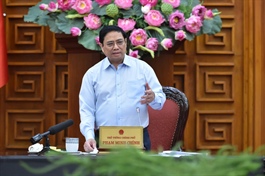CPTPP gains allure new states
CPTPP gains allure new states
Three years into implementation of the Comprehensive and Progressive Agreement for Trans-Pacific Partnership, a range of other diverse economies are seeking to fast-track their accession into the bloc – which in turn could help Vietnam integrate deeper into cross-border activities.

Vietnam is expected to reap many opportunities in increasing its trade and investment cooperation if new member economies successfully help to expand the Comprehensive and Progressive Agreement for Trans-Pacific Partnership.
Nguyen Thi Bich Thuy, vice director of the Ministry of Foreign Affairs’ Department for Multilateral Economy, told VIR that Vietnam may benefit massively from the extended deal (CPTPP).
“The CPTPP is surging to become a magnet for many economies to join. The pandemic crisis has been forcing many nations to find ways to recover, which are affected by a reduction of foreign markets and investment inflows, while being in critical need of generating more employment for their citizens,” Thuy said. “The CPTPP is considered by these economies as one of the best solutions as it offers flexible mechanisms in dealing with trade and investment obstructions and in trade facilitation,” she explained.
Economies including the United Kingdom, China, Taiwan, Ecuador, South Korea, Indonesia, Thailand, the Philippines, and Colombia have all expressed interest in joining the CPTPP, which represents a free trade area worth about $11 trillion in aggregate GDP.
Vietnam has been working closely with the UK, in particular, on boosting the latter’s negotiations to join the CPTPP as soon as possible.
The Ministry of Industry and Trade has covered opinions from relevant ministries and sectors about how Vietnam can benefit from the UK’s upcoming accession of the CPTPP and is likely next month to submit to the government a report on a master scheme on Vietnam’s negotiations regarding the UK’s accession.
It is expected that negotiations with CPTPP member state representatives, which are conducted with countries individually and simultaneously, will conclude at the year’s end.
During a June meeting in London between Vietnamese National Assembly Chairman Vuong Dinh Hue and senior officials of the UK, including Britain’s International Trade Secretary Anne Marie Trevelyan, both sides agreed to accelerate negotiations of the CPTPP which could lead to 99.9 per cent of British exports to members being eligible for tariff-free trade.
“CPTPP negotiations so far are positive,” Chairman Hue noted.
Creating competition
In 2021 when the UK-Vietnam Free Trade Agreement took effect, two-way trade turnover hit $6.61 billion, up 17.2 per cent on-year. As of June 20, the total of directly-registered investment capital into Vietnam from the UK stood at $4.15 billion for 467 projects.
In April, South Korea decided to join the CPTPP as it seeks to diversify its export portfolio amid heightened economic uncertainty. The CPTPP accession would help expand trade and investment for South Korea, raising its GDP by 0.33-0.35 per cent annually, the state-run Korea Institute for International Economic Policy estimated. The government will submit an official application after completing domestic procedures, and this application is expected to be seen at the end of this year.
Meanwhile, Thailand also has expressed its interest in joining the CPTPP mega deal, considering it an effective tool for recovering and developing its economy and making industries such as electronics and agriculture more competitive against rivals such as Vietnam and Malaysia.
However, the timeline for Thailand’s hopes remains unclear as it is now in the process of consulting with relevant stakeholders.
Senior economist Raymond Mallon told VIR that the CPTPP always envisaged that it would expand and included specific provisions for enlargement in the original agreement.
“It was originally thought that negotiations with the UK could be concluded relatively quickly because it would have to make relatively minor policy and/or institutional reforms to comply with CPTPP conditions,” Mallon said. “However, ongoing leadership turmoil in the UK has reignited debates about the benefits of trade there and may slow the accession process.”
Simplified facilitation
However, he argued that extending membership of the CPTPP to Taiwan, South Korea, and China had the potential to generate more immediate substantive benefits to Vietnam, because Vietnam is already closely linked to production networks and supply chains in these countries. Acceptance of other East Asian economies into the CPTPP, should further contribute to more harmonised regional rules of origin, renewed efforts to harmonise standards and to streamlined trade compliance mechanisms, and further reductions in tariffs and other trade and investment barriers that will contribute to further strengthening of regional production and consumption network linkages.
“Simplified trade facilitation regimes and strengthened investment and production linkages with Vietnam’s major economic partners could especially help small- and medium-sized enterprises to benefit from economic integration. It could also help reduce opportunities for trade related corruption,” Mallon said.
However, while the CPTPP includes built-in plans for expansion, it is not clear how long approvals for expansion may take. Existing members may well face resistance to moving on Taiwan and Chinese membership due to broader geo-political consideration.
Nguyen Lan Phuong from Baker McKenzie Vietnam said that the expanded CPTPP will benefit Vietnam significantly. “It has been proved to be an effective 21st century trade pact and the fact that many major economies such as China and the UK wish to join is an encouragement for existing members like Vietnam,” Phuong said.
“After three years into the implementation, the Vietnamese government has adopted and is formulating domestic regulations in order to take full benefits of the CPTPP and its enormous market, such as the data privacy protection decree and social media tax administration regulations. Vietnam has the potential to integrate deeper into an expanded CPTPP,” Phuong continued.
According to Phuong, an expanded CPTPP is good news for supply chains in Vietnam. On the downstream side, Vietnam origin goods already enjoy a cost advantage over competitor non-CPTPP goods via lower import tariff rates and streamlined trade procedures in the existing CPTPP member markets. Adding new CPTPP members will expand consumer markets for Vietnam origin goods.
On the upstream side, Vietnamese manufacturers can source materials from other CPTPP members to produce goods that will enjoy the same CPTPP benefits. “For example, a furniture manufacturer in Vietnam might source timber grown in Canada to produce wooden furniture, which may then enjoy the benefits of the CPTPP because both Vietnam and Canada are CPTPP members,” she added. “An expanded CPTPP would allow manufacturers to source materials from additional markets, without forfeiting the benefits offered by the CPTPP.”
If the CPTPP is expanded, enterprises from many that already have trade deals with Vietnam, such as the Regional Comprehensive Economic Partnership, Vietnam-Korea Free Trade Agreement, and the ASEAN Free Trade Area, can select preferential tariff schemes under either the CPTPP and these agreements to apply to, so that their goods can find it more favourable to be exported to member markets, according to the Centre for WTO and International Trade under the Vietnam Chamber of Commerce and Industry.





















